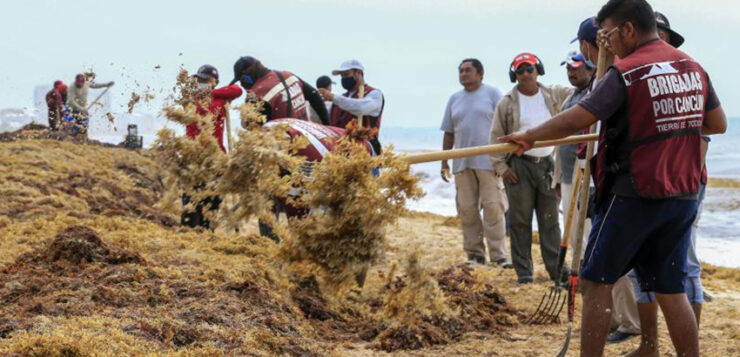Recent high winds and big waves making the problem harder to contain
Large amounts of sargassum continue to plague many beaches in Quintana Roo, although the overall situation in the Caribbean coast state has improved considerably over the last week.
There are 22 beaches with excessive amounts of the smelly seaweed and 15 with abundant quantities, according to the Quintana Roo Sargassum Monitoring Network, which published an updated map on Wednesday morning. There were 47 beaches with excessive quantities of sargassum on Tuesday of last week.
The latest map shows that eight beaches in the Tulum area and all those located on the east coast of Cozumel have excessive amounts of sargassum as do Playa Aventuras, Punta Esmeralda and Playa El Recodo in Playa del Carmen and Nizuc Playa Coral in Cancún. Other beaches in Cancún have abundant, moderate or very low quantities.
The navy said in its daily sargassum report on Tuesday that the arrival of abundant quantities was expected in the south of Quintana Roo, affecting the coastline between Mahahual and Tulum. Lesser quantities were expected to wash up on beaches in Solidaridad, the municipality where Playa del Carmen is located, and on Cozumel.
Experts at the University of South Florida said that sargassum in the Caribbean Sea was at a “historical record” in May and that large quantities could wash up on beaches throughout the 2021 sargassum season, as occurred in 2018.

The navy, which leads efforts to remove sargassum from the sea before it reaches beaches, last week identified more than 2,000 tonnes of the weed off the coast of Quintana Roo.
Governor Carlos Joaquín acknowledged Monday that authorities’ capacity to stop the arrival of sargassum on the state’s famous white sand beaches has been affected by weather conditions.
“[It’s been] impossible to stop the brown tide when the wind is strong and the sea is crashing with so much force, as has been happening in recent days,” he said.
Large swells allow the seaweed to breach anti-sargassum barriers and prevent the navy’s sargassum-gathering vessels from going to sea, Joaquín said.
There are many difficulties in the quest to stop sargassum from washing up on beaches, the governor said. “It’s like trying to control or stop the winds during a storm or hurricane,” he said.
Joaquín said that progress has been made, citing the installation of barriers and the construction and use of sargassum-gathering vessels, among other measures, but the seaweed has recently arrived in such large volumes that it appears no work has been done. The governor also said that about 16,000 tonnes of sargassum has been cleared from beaches so far this year and approximately 700 tonnes has been removed from the sea.

But a coalition of environmental and tourism groups wants the authorities to do more to address the sargassum problem, circulating a petition to that end that declared that “we are drowning in sargassum!”
“The predictions are that the amounts arriving in 2021 may be larger” than in 2018 or 2019, the petition said.
“If this isn’t handled immediately, the environment, public health and the local economy are in grave danger,” said the coalition, made up of 29 groups including the Cancún Hotel Association and the Mexican Center of Environmental Law.
“Tonnes of sargassum piling up and decaying on beaches has contributed to erosion, which wipes out sea grasses and marine life, deteriorates coastal water quality and seriously affects the coral reefs of Mexico’s Caribbean,” it said.
Environmentalists have also warned that if sargassum collected from beaches and the sea is simply sent to landfills to rot, the weed – which emits sulfuric acid and arsenic once removed from water – could contaminate aquifers and supplies of fresh water.
Very little sargassum reached Quintana Roo beaches prior to 2014 but very large quantities of the weed have arrived annually since then. Climate change, pollution from fertilizers and changing ocean flows and currents are among the factors cited for the increased quantities, much of which floats up to the Caribbean sea from the Atlantic Ocean off the east coast of South America.

The annual arrival of sargassum is considered a deterrent to tourism in Quintana Roo, but that sector is currently recovering strongly from the pandemic-induced downturn.
Joaquin said on Twitter that 506 flights landed or took off from airports in the state over the weekend, the highest number since the start of the pandemic. The reactivation of tourism in Quintana Roo, and in states such as Baja California Sur and Yucatán, has been blamed for a recent increase in coronavirus case numbers.
“We’re recovering our tourism so be doubly careful,” Joaquin wrote on Twitter. “Use a face mask, [keep]a healthy distance [from others]and wash your hands. The vaccine doesn’t make you immune from #COVID19.”
With reports from AP and El Economista





